Table of Contents

If you understand polar patterns, selecting an appropriate microphone for specific needs takes minutes. Also, polar patterns are essential for getting the best recording out of your microphone. They influence how directional a microphone is and how it captures sound. Understanding these aspects of audio recording is critical if you want to achieve excellent results.
The more you understand them, the more easily you can capture vocals from singers in both live and studio situations because they focus on specific gestures within a given area.
If you want to learn more, this guide will provide you with everything you need to know to call yourself a pro and improve the quality of your recordings.
What Are Microphones Polar Patterns?
A microphone polar pattern is an area near a microphone where sound is captured and is considered the most sensitive range. Therefore, it is essential to know about polar patterns when choosing a microphone.
These settings in a microphone specify the location from which the mic would best record the sound. In addition, they help you define how much audio would be picked up from specific and various other directions.
These patterns are the microphone’s inherent directionality. For example, microphone polar patterns could save or spoil your audio results while recording vocals or live sound.
How Are Microphone Polar Patterns Measured?
Polar pattern measurement is the technique of measuring and plotting a microphone’s relative output signal strength. It starts with a sound source, typically a calibrated loudspeaker that can produce the same level of tones across different frequencies.
The microphone is then placed at a pre-determined distance from this loudspeaker and is delicately rotated 360° around the center of its capsule.
It should be kept in mind that the diaphragm’s center of the front side is stationary, which will ensure accurate polar pattern measurement.
This will allow you to accurately map out the polar pattern by comparing the level to its starting 0° on-axis reading over each angle of incidence.
It accurately shows how directional or sensitive a given microphone is, helping you ensure your recording needs are met.
How To Read A Polar Pattern Diagram?
A polar pattern diagram represents the directionality and sensitivity of the audio recordings displayed on a sound field.
It consists of a full 360° circle representing 0° at the front of the microphone with maximum sensitivity. In addition, this scale has smaller circles representing a 5dB decrease in sensitivity level.
What Is Decibel (dB)?
The decibel (dB) is a relative unit based on a logarithmic scale that measures audio-level changes. It measures sound pressure levels in audio, and in the case of microphones, it calculates how loud sound can be in decibel units.
Types Of Polar Patterns
-
Cardioid
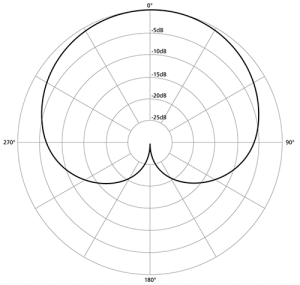 A cardioid polar pattern is a heart-shaped pickup pattern that is uni-directional, meaning that it captures sound from one sound source and reduces the sound coming from the back and the sides.
A cardioid polar pattern is a heart-shaped pickup pattern that is uni-directional, meaning that it captures sound from one sound source and reduces the sound coming from the back and the sides.
In this pattern, the microphone’s capsule has the highest sensitivity directly in its front at 0°, while being least sensitive to sound in the exact opposite direction at 180° and moderately sensitive to sound coming from the sides at 90°and 270°.
It is particularly useful for capturing dry signals as it helps to minimize unwanted reflections from a room and mask noise, such as background artists humming.
This makes it easier for an audio engineer to obtain the crisp and clean sound of desired subjects without too many secondary reverberations.
-
Supercardioid
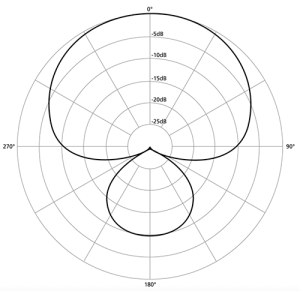 The supercardioid polar pattern is highly directional and focused on the audio source present. It also has a sensitivity at the back lobe. This enables it to achieve a higher gain before feedback during live events.
The supercardioid polar pattern is highly directional and focused on the audio source present. It also has a sensitivity at the back lobe. This enables it to achieve a higher gain before feedback during live events.
Super cardioids have a 5:3 ratio of bidirectional to omnidirectional patterns, effectively reducing pickup of noise at the sides while still having two null points at 127° and 233°. As a result, they can be highly effective when used in both studio and live settings.
When using a super-cardioid mic, you are also sure to capture a dry signal as most of your sound source’s audio will be picked up directly by the mic with minimal room ambiance.
-
Hypercardioid
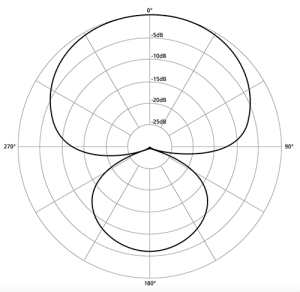 The hyper-cardioid polar pattern captures sound with the primary sensitivity in front of the microphone. It is more focused and directed from the front side to the audio source while rejecting the unwanted sound surrounding the microphone.
The hyper-cardioid polar pattern captures sound with the primary sensitivity in front of the microphone. It is more focused and directed from the front side to the audio source while rejecting the unwanted sound surrounding the microphone.
Hypercardioid pickup patterns show the maximum sensitivity on its on-axis sounds which is the area in which the audio source is present.
Its design produces a 3:1 ratio with bidirectional Omni patterns and allows for greater recording control than other mics that might produce more reverberation within a space.
The larger rear lobe of sensitivity creates null points at 110° and 250°, meaning that there are portions in its track field where sound isn’t recorded. All this makes it perfect for honing in on targeted areas when trying to achieve clear sound recordings.
-
Omnidirectional
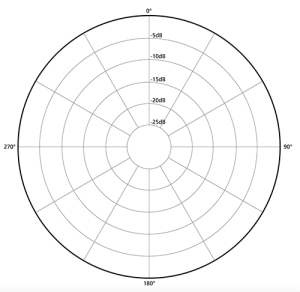 The omnidirectional polar pattern captures sound in an acceptance angle of a 360-degree radius and is highly sensitive to sound at all angles. Therefore, it captures sound from around the area where the flat frequency is essential, like in studio recordings and live events.
The omnidirectional polar pattern captures sound in an acceptance angle of a 360-degree radius and is highly sensitive to sound at all angles. Therefore, it captures sound from around the area where the flat frequency is essential, like in studio recordings and live events.
It is sensitive to sound coming from any direction. This is because this pickup pattern operates on the acoustic principle, which states that the only side of the diaphragm is open for external sound pressure.
-
Figure-8
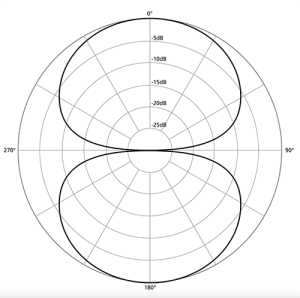 Figur-8 pick-up pattern is described as capturing audio from the back and the front while rejecting the sound coming from the sides. It uses two diaphragms arranged at 0° and 180°, which offer the same sensitivity.
Figur-8 pick-up pattern is described as capturing audio from the back and the front while rejecting the sound coming from the sides. It uses two diaphragms arranged at 0° and 180°, which offer the same sensitivity.
It produces minor sensitivity at 90° and 270°, making it ideal when you don’t want a signal from those angles to bleed into the microphone.
Its unique strength is its side rejection which is the most effective pattern for managing interference from nearby instruments and signals.
It has a low bass response, making it useful for recording in live environments where many instruments share one room.
Other Factors Regarding Polar Patterns
-
Distance Factor
The distance factor refers to the distance between the audio source and the microphone. A directional microphone can even pick up the same sound levels as an omnidirectional microphone when it is placed far away from the sound source compared to the other one (omnidirectional microphone).
This is because the main function of a directional mic is to pick up sound from a single direction. Hence, it has more power in that direction. Whereas when it comes to an omnidirectional microphone, it has to concentrate on more than one direction to get clear audio, hence should be placed closer to the studio source.
Although directional mics are great for recording in noisy environments, they struggle to capture sound with clarity and accuracy when placed too close to the sound source.
Placing a directional mic at least four times farther away than its omnidirectional counterpart will give you a sound with the same direct-to-reflected vocal balance without sacrificing much in terms of high-frequency presence.
-
Acceptance Angle
The acceptance angle of a microphone is the maximum angle at which sound does not drop by more than 3dB.
It’s important to remember that if a sound source is placed outside the acceptance angle, there may be negative consequences for the quality of the sound recorded.
This could range from slight distortion or muffling to an almost complete sound loss, especially at higher frequencies.
As such, it’s generally not recommended to place a sound source outside this accepted angle unless necessary due to specific circumstances, such as when attempting to reduce room reverberation or eliminate noise from another source.
-
Maximum Reduction
The angle at which the microphone is least sensitive, that angle is referred to as maximum reduction. The maximum reduction angle of a microphone is a key factor in determining its sensitivity. If the maximum angle is decreased, the microphone’s directional sensitivity and overall sound quality will also be reduced.
With a low maximum reduction angle, sound waves will only be picked up from within a narrow area, and reverberation or static noise can be minimized.
A microphone with a lower maximum reduction angle will reject nearby sound sources and provide users with better sound clarity and accuracy.
The lower the reduction angle of the microphone, the less sensitive it will be, which makes it ideal for specific settings such as recording in loud environments or capturing vocals from single performers.
-
Rear Rejection
The loss of sound in dB at the angle of 180° is referred to as rear rejection. Rear rejection is a decrease in sensitivity when a sound source moves around the directional pattern of the mic.
dB values measure sound pressure levels, so it’s easy to see how such a drastic decrease in the signal at this degree alters not only the nature of the sound produced by a speaker but also allows for more directional control over where sound travels; this is especially useful in concerts or live performances as well as for professional recording booths.
With such significant dB reductions at an angle of 180°, noise becomes much more manageable and audio engineers can create unique and intricate soundscapes with intent and accuracy.
-
Side Rejection
At the 90° angle, the amount of sound signal reduction dB is referred to as side reduction. Side rejection is not high in omnidirectional microphones. Whereas it is high in hypercardioid microphones.
What Polar Pattern Is Best For Vocals?
The cardioid polar pattern is considered best for vocals as it is more sensitive to sound coming from the front of the microphone than it is sensitive to the background sound.
This polar pattern blocks out the ambient noises and focuses on the audio source essential for maintaining the audio quality.
The cardioid style of polar pattern is suitable for vocals like podcasters or anyone who likes to talk directly to the audience using a microphone.
Conclusion
Polar Patterns are complicated topics that require careful consideration, also their understanding benefits audio engineers and audiophiles.
It allows for a greater range of accessible sonic resources, from producing subtle yet identifiable variations between sources to the more exaggerated changes that generate “special effects” sounds in projects.
Using the knowledge gained in studying polar patterns is a valuable tool for creating the original vision for any audio-related project. In addition, taking some time to understand them can significantly enhance your creative process and lead you to unexpected paths in your practice as an artist.
FAQs
Choosing the right polar pattern important as it will help you reject unwanted noises that can bleed into your signal. It determines how much signal would be captured by your microphone from various directions.
Yes, some microphones have switchable polar patterns which allow you to change the pattern depending on the situation. Other microphones have a fixed polar pattern and cannot be changed.
Omnidirectional microphones are great for capturing ambient sounds and group settings where you want to capture sounds from all directions. They are also useful for capturing sounds in noisy environments where background noise needs to be captured with the desired sound.